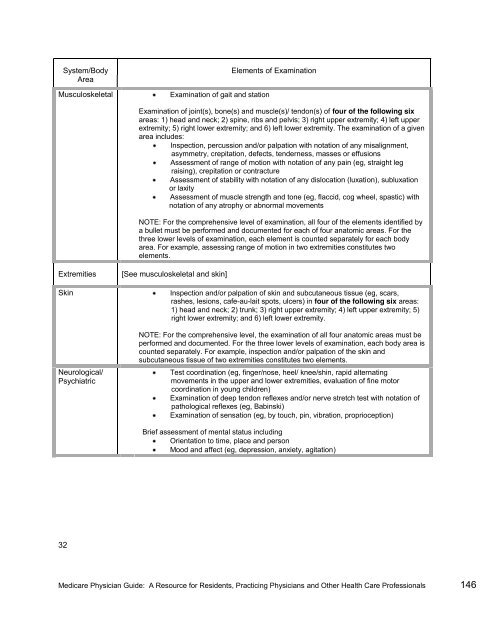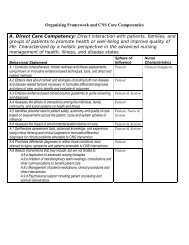Physician
Medicare Physician Guide - National Association of Clinical Nurse ...
Medicare Physician Guide - National Association of Clinical Nurse ...
- No tags were found...
Create successful ePaper yourself
Turn your PDF publications into a flip-book with our unique Google optimized e-Paper software.
System/Body<br />
Area<br />
Musculoskeletal<br />
Examination of gait and station<br />
Elements of Examination<br />
Examination of joint(s), bone(s) and muscle(s)/ tendon(s) of four of the following six<br />
areas: 1) head and neck; 2) spine, ribs and pelvis; 3) right upper extremity; 4) left upper<br />
extremity; 5) right lower extremity; and 6) left lower extremity. The examination of a given<br />
area includes:<br />
Inspection, percussion and/or palpation with notation of any misalignment,<br />
asymmetry, crepitation, defects, tenderness, masses or effusions<br />
Assessment of range of motion with notation of any pain (eg, straight leg<br />
raising), crepitation or contracture<br />
Assessment of stability with notation of any dislocation (luxation), subluxation<br />
or laxity<br />
Assessment of muscle strength and tone (eg, flaccid, cog wheel, spastic) with<br />
notation of any atrophy or abnormal movements<br />
NOTE: For the comprehensive level of examination, all four of the elements identified by<br />
a bullet must be performed and documented for each of four anatomic areas. For the<br />
three lower levels of examination, each element is counted separately for each body<br />
area. For example, assessing range of motion in two extremities constitutes two<br />
elements.<br />
Extremities<br />
Skin<br />
Neurological/<br />
Psychiatric<br />
[See musculoskeletal and skin]<br />
Inspection and/or palpation of skin and subcutaneous tissue (eg, scars,<br />
rashes, lesions, cafe-au-lait spots, ulcers) in four of the following six areas:<br />
1) head and neck; 2) trunk; 3) right upper extremity; 4) left upper extremity; 5)<br />
right lower extremity; and 6) left lower extremity.<br />
NOTE: For the comprehensive level, the examination of all four anatomic areas must be<br />
performed and documented. For the three lower levels of examination, each body area is<br />
counted separately. For example, inspection and/or palpation of the skin and<br />
subcutaneous tissue of two extremities constitutes two elements.<br />
Test coordination (eg, finger/nose, heel/ knee/shin, rapid alternating<br />
movements in the upper and lower extremities, evaluation of fine motor<br />
coordination in young children)<br />
Examination of deep tendon reflexes and/or nerve stretch test with notation of<br />
pathological reflexes (eg, Babinski)<br />
Examination of sensation (eg, by touch, pin, vibration, proprioception)<br />
Brief assessment of mental status including<br />
Orientation to time, place and person<br />
Mood and affect (eg, depression, anxiety, agitation)<br />
32<br />
Medicare <strong>Physician</strong> Guide: A Resource for Residents, Practicing <strong>Physician</strong>s and Other Health Care Professionals 146





